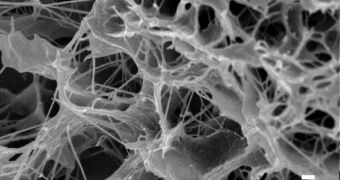Scientists at the University of Wisconsin-Madison announce the development of a new, super-strong type of collagen, the elastic tissue inside our bodies. The new variant is extremely strong, and represents a highly stable version of the one inside humans, its creators say. They add that the material could soon be made a part of therapies against diseases such as arthritis, or other conditions in which the patients suffer from defects of collagen. Details of the discovery appear in the January 12 issue of the respected journal Proceedings of the National Academy of Sciences (PNAS).
“It's by far the most stable collagen ever made,” UWM Chemistry and Biochemistry Professor Ron Raines, who has also been the leader of the new study, explains. Collagen, he points out, plays one of the most vital functions in the entire human body. The protein produces strong sheets and filaments that are also elastic and help sustain the structure of skin, internal organs, cartilage and bones. Most of the tissue that separates or envelops internal organs, sustaining them and keeping them from mixing is made up of collagen. Therefore, if defects occur in its production process or structure, the repercussions for health can be devastating.
In fact, the protein is so important, that doctors have been using it for decades on burn victims. However, the problem with this is that the collagen needed was extracted from cows. In spite of its efficiency, this treatment presents a high risk of transplant rejection, most often on account of species differences. Researchers in Raines' team have been working on a method of producing collagen in the lab since 2006, when they registered the first success in this field. Using funding from the US National Institutes of Health (NIH), the investigators have now managed to produce a super-strong variety of the protein, in tissues longer than any other found in nature.
“This hyper-stable collagen is really a testament to the power of modern protein chemistry,” the team leader says. “The breakthrough of this approach was the use of rigid analogues that have shapes similar to [the shapes the natural amino acids take] in the folded, functional form of the protein,” he adds. The innovation presents doctors with the possibility of developing treatments for millions of people. In the US alone, the number of people with arthritis exceeds 46 million. Other conditions too are caused by the breakdown of natural collagen.

 14 DAY TRIAL //
14 DAY TRIAL //